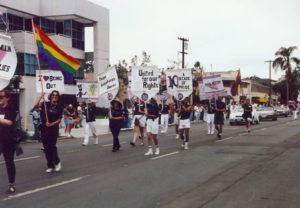1990
 After the success of the 1989 event, the committee members decided to form a permanent organization, and thus San Diego Lesbian & Gay Pride was born. The Board of Directors was largely composed of members of the previous year’s committee, with a few new additions. Two of the new members of the Board were Larry Baza and Vertez Burks, who were encouraged to join by Co-Chair Christine Kehoe.
After the success of the 1989 event, the committee members decided to form a permanent organization, and thus San Diego Lesbian & Gay Pride was born. The Board of Directors was largely composed of members of the previous year’s committee, with a few new additions. Two of the new members of the Board were Larry Baza and Vertez Burks, who were encouraged to join by Co-Chair Christine Kehoe.
The addition of two people of color on the Board was a sign that the organization was making an effort to reach out to all members of our community. Pride had been perceived to be too white for too long and that changed throughout the ‘90s. A concerted effort was made to make sure that people of color were represented among the Grand Marshals, rally speakers and entertainment at the festival. Pride was moving with the times and there would be no turning back.
It looked like 1990 was on target to be another huge year for the Pride organization. They had the same talented people on the Board and on staff, and they were doing everything right. They had a budget, they had staff and volunteers, they had a multi-cultural lineup of entertainment, and they had a plan. What they didn’t have was a giant-sized umbrella.
Rain, Rain, Go Away…
In the week leading up to the June 9th and 10th Pride weekend, staff and volunteers worked diligently to prepare for the parade and festival. Friday night, workers toiled late into the night to have the festival ready in time to open the gates Saturday after the parade. The festival was once again held in the parking lot of the Old Naval Hospital, which borders Interstate-5 to the south.
That night, the sky let loose with an unprecedented amount of wind and rain. Joe Mayer recalls getting a 2:00 a.m. phone call from a panicked Tim Williams. The tents had been weighted down with concrete, but the wind was so strong that they were being blown down the hill onto the freeway. The festival site was decimated by the storm. Tents had to be retrieved and set up again, the handmade signs were either completely destroyed or were a mess of runny ink.
Eventually, the festival grounds were put back in some semblance of order, and the next question was the parade. It rained all night and all morning. Would people even show up to watch the parade in the rain? Contingents began to show up but the rain had taken its toll on the floats and many participants did all they could to huddle someplace out of the rain. The parade was scheduled to start at noon and late into the morning it didn’t look like the rain was going to let up.
Minutes before the parade was scheduled to start, the downpour became a trickle and then stopped altogether. The parade went on as scheduled, though slightly soggier than expected. Along the parade route, attendance was affected by the weather, but people still came out to watch the parade.
The festival went on as planned, although it too was affected by the bad weather. Festival attendance was down from the previous year. In 1989 a total of 7,924 tickets were sold, but in 1990 that number was down to only 5,718 tickets. The festival attendance was expected to grow, but it did the opposite.
Goodbye June
In the end, Pride didn’t meet expectations, but it could have been much worse. Only a strict adherence to the budget and a last-minute reprieve from the weather kept it from being a total disaster. Once the numbers came in, Pride essentially broke even, reporting only a minor deficit of -$450 after expenses. Still, it could have been better, so the Board began contemplating a change of dates.
For years, it was thought that all Pride celebrations had to take place in June in order to commemorate Stonewall. This created conflicts in states or regions that had multiple large cities in the area. Here in California, San Diego, Los Angeles, San Francisco, Long Beach, and many smaller cities, all wanted to have Pride celebrations in June, but they also wanted to avoid competing for the same participants.
Dates were constantly juggled until finally, Long Beach broke out of the mold and moved their event to May. The threat of another Pride falling victim to “June Gloom” encouraged the San Diego Pride Board to follow Long Beach’s example and leave the month of June behind. Beginning in 1991, San Diego Pride would be celebrated in the second half of July.
The change in dates would be the second of the three most important changes that would help take San Diego Pride to the next level.